Why Do We All Look Different?
Have you ever wondered why no two people in your class look exactly alike (except identical twins)? Why do some people have straight hair while others have curly? Why are some of us tall and others short? The answer lies in one of the most fascinating topics in biology: variation and selection.
This topic isn’t just about understanding differences in appearance. It’s the key to understanding how species survive, adapt, and evolve over millions of years. From antibiotic-resistant bacteria to the different breeds of dogs, from Darwin’s finches to the peppered moth during the Industrial Revolution-variation and selection explain it all.
In this guide, we’ll explore everything you need to know about Topic 18 for your IGCSE Biology (0610) exam. Whether you’re just starting or need a comprehensive revision, this post will break down complex concepts into easy-to-understand sections with plenty of examples, diagrams, and exam tips.
Let’s dive in!
What is Variation?
Variation refers to the differences between individuals of the same species. Look around your classroom-everyone has two eyes, a nose, and a mouth, but each person looks unique. That’s variation in action!
Types of Variation
There are two main types of variation you need to understand:
1. Continuous Variation
Continuous variation shows a range of values between two extremes with no distinct categories. These characteristics are usually controlled by many genes (polygenic inheritance) and are heavily influenced by the environment.
Examples of Continuous Variation:
- Height in humans
- Mass (weight)
- Skin color
- Hand span
- Leaf length in plants
If you measured the height of everyone in your year group and plotted it on a graph, you’d get a bell-shaped curve (normal distribution). Most people would cluster around the average height, with fewer people at the very tall or very short extremes.
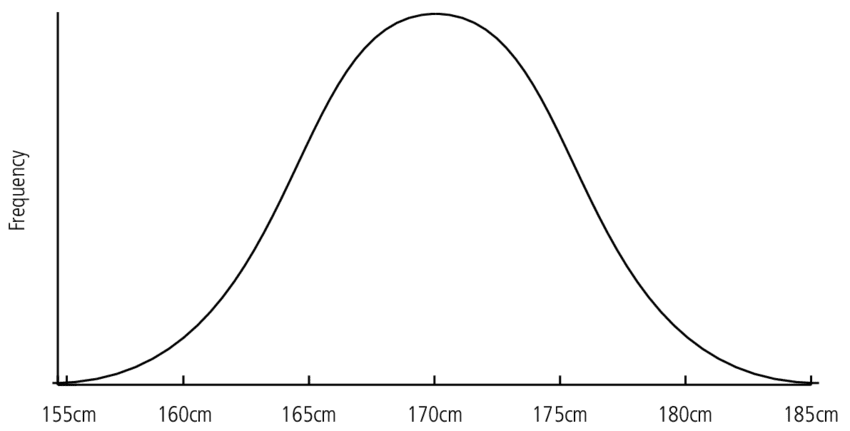
2. Discontinuous Variation
Discontinuous variation shows distinct categories with no intermediates. These characteristics are usually controlled by a single gene or a few genes, with little or no environmental influence.
Examples of Discontinuous Variation:
- ABO blood groups (A, B, AB, O)
- Earlobe attachment (attached or free)
- Ability to roll tongue
- Sex (male or female)
- Flower color in some plants (red or white, with no pink)
If you surveyed your class for blood groups and plotted the data, you’d get a bar chart with distinct categories, not a smooth curve.
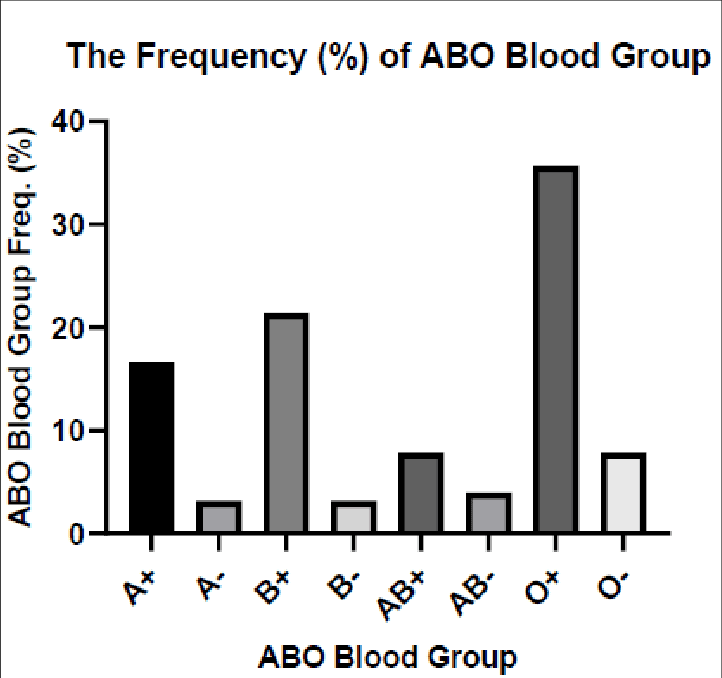
What Causes Variation?
Understanding the causes of variation is crucial for your exam. There are two main causes:
1. Genetic Variation (Inherited)
Genetic variation comes from differences in genes that we inherit from our parents. This type of variation is passed from one generation to the next through reproduction.
How Genetic Variation Arises:
- Sexual reproduction: During gamete formation (meiosis), chromosomes are shuffled, and genes are mixed. When a sperm fertilizes an egg, you get a unique combination of genes from both parents
- Mutations: Random changes in DNA can create new alleles (versions of genes)
- Random assortment: Chromosomes are distributed randomly to gametes during meiosis
- Crossing over: Chromosomes exchange genetic material during meiosis
Examples of Genetic Variation:
- Eye color
- Natural hair color
- Blood group
- Inherited diseases (like sickle cell anemia)
2. Environmental Variation (Acquired)
Environmental variation results from the influence of the environment on an organism. These characteristics are NOT inherited-they’re acquired during an organism’s lifetime.
Examples of Environmental Variation:
- Scars from injuries
- Muscles developed through exercise
- Language spoken
- Suntan
- Weight loss or gain due to diet
3. Combined Effects
Most characteristics show variation due to BOTH genetic and environmental factors working together. This is where it gets interesting!
Example: Your Height
Your height is determined by:
- Genes from your parents (genetic potential)
- Diet during childhood (especially protein and calcium)
- Exercise and physical activity
- Health (diseases can stunt growth)
- Hormones (like growth hormone)
You might have genes for being tall, but if you don’t get proper nutrition during your growing years, you won’t reach your full genetic potential.
| Type of Variation | Genetic | Environmental | Both (Genetic + Environmental) |
|---|---|---|---|
| Eye color | ✅ Determined by genes | ❌ | ❌ |
| Natural hair color | ✅ Inherited from parents | ❌ | ❌ |
| Scars | ❌ | ✅ Caused by injury or accident | ❌ |
| Language spoken | ❌ | ✅ Depends on upbringing | ❌ |
| Height | ❌ | ❌ | ✅ Influenced by genes and nutrition |
| Weight | ❌ | ❌ | ✅ Affected by genes and lifestyle |
| Intelligence | ❌ | ❌ | ✅ Influenced by heredity and education |
| Skin color | ✅ Basic tone inherited | ✅ Sun exposure can darken skin | ✅ Combined effect |
| Athletic ability | ❌ | ❌ | ✅ Depends on genes and training |
| Blood group | ✅ Determined by alleles | ❌ | ❌ |
| Accent | ❌ | ✅ Learned from environment | ❌ |
Adaptation: Survival of the Fittest
Adaptation is a characteristic that makes an organism well-suited to survive in its environment. Over many generations, organisms develop features that help them survive and reproduce.
Types of Adaptations
1. Structural (Anatomical) Adaptations
These are physical features of an organism.
Examples:
- Polar bear: Thick fur and fat layer for insulation in Arctic cold; white fur for camouflage
- Cacti: Thick stems to store water; spines instead of leaves to reduce water loss; deep roots to absorb water
- Arctic fox: Small ears to reduce heat loss; thick white fur in winter (brown in summer for camouflage)
- Camel: Hump stores fat (not water!); long eyelashes to keep sand out; wide feet to walk on sand
2. Physiological (Functional) Adaptations
These are internal processes and chemical reactions.
Examples:
- Desert animals: Produce very concentrated urine to conserve water
- Snakes: Produce venom to kill prey
- Some bacteria: Produce antibiotics to kill competing bacteria
- Humans at high altitude: Produce more red blood cells to carry oxygen
3. Behavioral Adaptations
These are actions or behaviors that help survival.
Examples:
- Migration: Birds flying south for winter to find food
- Hibernation: Bears sleeping through winter when food is scarce
- Nocturnal behavior: Desert animals being active at night when it’s cooler
- Pack hunting: Wolves hunting in groups to catch larger prey
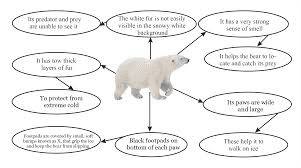
Natural Selection: Darwin’s Big Idea
Natural selection is the process by which organisms that are better adapted to their environment are more likely to survive and reproduce, passing on their advantageous characteristics to the next generation.
This is the mechanism behind evolution-how species change over time.
The Theory of Natural Selection (Step-by-Step)
Here’s how natural selection works:
Step 1: Variation
Within any population, there is genetic variation. Individuals have different characteristics.
Step 2: Competition
Organisms produce more offspring than can survive. There’s competition for limited resources (food, water, mates, shelter).
Step 3: Selection
Organisms with characteristics that give them an advantage are more likely to survive (survival of the fittest). This isn’t about being the strongest-it’s about being the best suited to the environment.
Step 4: Reproduction
Survivors are more likely to reproduce and pass on their advantageous alleles (genes) to their offspring.
Step 5: Inheritance
The next generation inherits these favorable characteristics.
Step 6: Gradual Change
Over many generations, the frequency of advantageous alleles increases in the population. The species gradually becomes better adapted.
Classic Examples of Natural Selection
Example 1: The Peppered Moth (Biston betularia)
This is one of the most famous examples of natural selection observed in real-time!
Before the Industrial Revolution (Pre-1800s):
- Most trees had light-colored bark with lichens
- Light-colored (peppered) moths were camouflaged against the bark
- Dark moths were easily spotted and eaten by birds
- Light moths were common; dark moths were rare
During the Industrial Revolution (1800s):
- Pollution killed lichens and darkened tree bark with soot
- Dark moths became camouflaged
- Light moths became visible and were eaten by birds
- Dark moths survived better and reproduced more
- The population shifted-dark moths became common
After Clean Air Acts (Late 1900s):
- Pollution decreased, lichens returned
- Light moths became advantageous again
- The population shifted back toward light-colored moths
Key Point: The environment changed, and natural selection favored different variations at different times. The moths didn’t “choose” to change color-those with the advantageous color simply survived better!
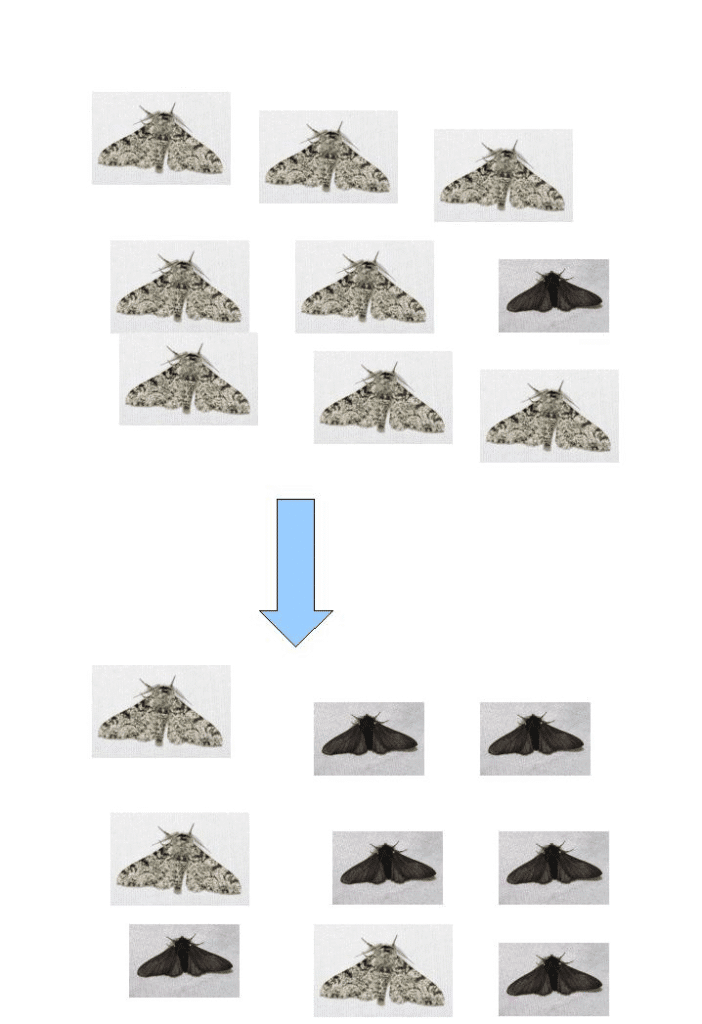
Example 2: Antibiotic Resistance in Bacteria
This is a modern, relevant example that affects human health.
How It Happens:
- Variation: In a bacterial population, random mutations create some bacteria resistant to antibiotics
- Exposure: When antibiotics are used, most bacteria die
- Selection: Resistant bacteria survive and reproduce
- Reproduction: They multiply rapidly (bacteria can divide every 20 minutes!)
- Result: A new population of antibiotic-resistant bacteria
Why This Matters:
- Overuse of antibiotics increases antibiotic resistance
- Diseases become harder to treat
- “Superbugs” like MRSA (Methicillin-resistant Staphylococcus aureus) are major health threats
Prevention Tips:
- Complete the full course of antibiotics (don’t stop when you feel better)
- Don’t use antibiotics for viral infections (they only work on bacteria)
- Reduce unnecessary antibiotic use in farming
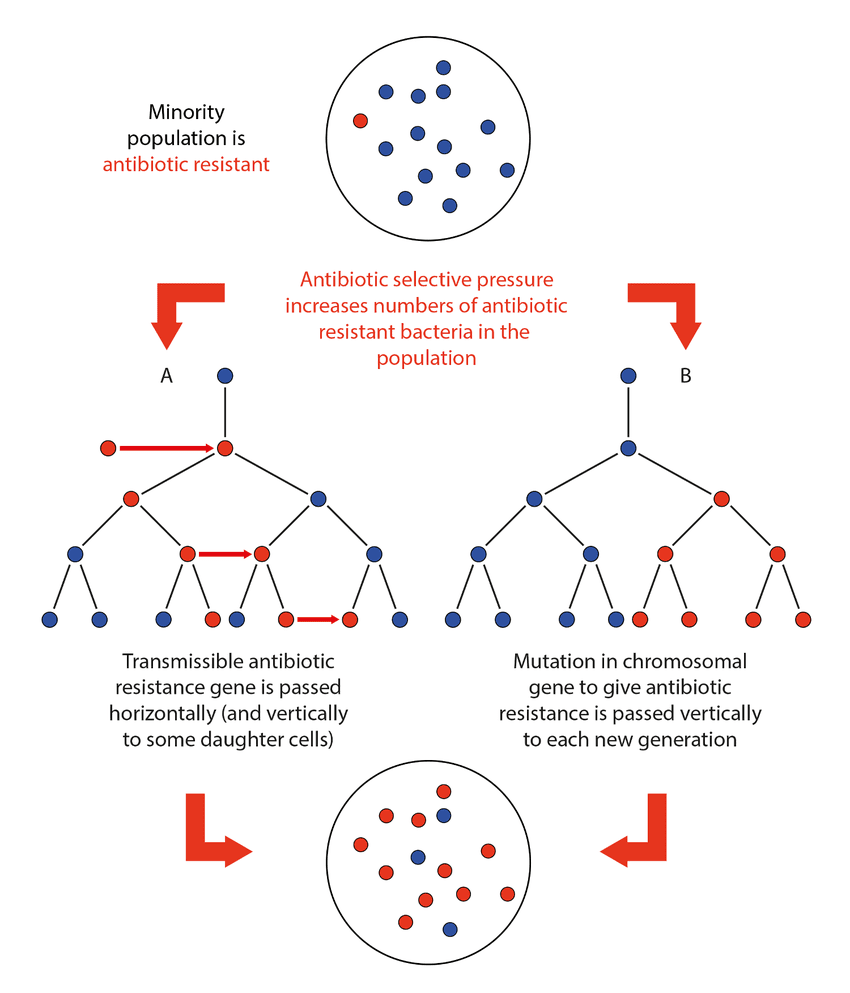
Example 3: Darwin’s Finches
When Charles Darwin visited the Galápagos Islands, he noticed 13 different species of finches, each with different beak shapes.
Observation:
- Large, strong beaks: For cracking hard nuts and seeds
- Long, thin beaks: For catching insects
- Sharp, pointed beaks: For eating grubs from trees
- Medium beaks: For eating soft seeds
Explanation:
- All finches descended from a common ancestor
- Different islands had different food sources
- Natural selection favored different beak shapes on different islands
- Over time, populations became so different they became separate species
This is an example of adaptive radiation-one ancestral species evolving into many different species to fill different ecological niches.
Selective Breeding (Artificial Selection)
While natural selection happens in nature, humans can also select for desirable characteristics. This is called selective breeding or artificial selection.
How Selective Breeding Works
- Choose parents with desirable characteristics
- Breed them together
- Select offspring showing the desired trait most strongly
- Repeat over many generations
- Result: A breed with enhanced characteristics
Examples of Selective Breeding
In Animals:
- Dogs: All breeds (from Chihuahuas to Great Danes) descended from wolves through selective breeding for size, temperament, hunting ability, appearance
- Cattle: Bred for high milk yield or more meat
- Racehorses: Bred for speed
- Chickens: Bred for more eggs or more meat
In Plants:
- Wheat: Larger grains, disease resistance
- Roses: Different colors, fragrances, size
- Vegetables: Cauliflower, broccoli, cabbage, Brussels sprouts all bred from the same wild mustard plant!
Advantages of Selective Breeding
- Increases yield (more milk, eggs, grain)
- Improves quality (taste, appearance)
- Develops disease resistance
- Creates desirable features (size, color, temperament)
Disadvantages of Selective Breeding
- Reduced genetic variation: Inbreeding can make populations vulnerable
- Health problems: Some dog breeds have breathing or joint problems
- Loss of other traits: Focusing on one characteristic might lose others
- Vulnerability to disease: Less genetic diversity means a new disease could wipe out a whole breed
Mutation: The Source of New Variation
Mutation is a random change in the DNA sequence. Mutations are the ultimate source of all new alleles and genetic variation.
Types of Mutations
By Effect:
- Beneficial: Give an advantage (rare)-example: mutation causing antibiotic resistance
- Harmful: Disadvantage-example: mutations causing genetic diseases
- Neutral: No effect on survival or reproduction (most common)
By Cause:
- Spontaneous: Occur naturally during DNA replication (mistakes)
- Induced: Caused by mutagens (factors that increase mutation rate)
Mutagens (Causes of Mutation)
- Radiation: X-rays, gamma rays, UV light
- Chemicals: Tobacco smoke, certain pesticides, some chemicals in processed foods
- Biological agents: Some viruses
Important Points About Mutations
Mutations are random-they don’t happen because an organism “needs” them
Most mutations are neutral or harmful
Beneficial mutations are rare but important for evolution
Mutations in body cells aren’t inherited
Only mutations in sex cells (gametes) can be passed to offspring
Mutation rates are low but can be increased by mutagens
Gene vs. Chromosome Mutations
Gene Mutations:
- Change in a single gene (DNA sequence)
- Example: Sickle cell anemia
Chromosome Mutations:
- Change in chromosome number or structure
- Example: Down syndrome (extra chromosome 21)
Quick Revision Notes
Key Definitions
Variation: Differences between individuals of the same species
Continuous variation: A range of values with no distinct categories (e.g., height)
Discontinuous variation: Distinct categories with no intermediates (e.g., blood group)
Adaptation: A characteristic that makes an organism suited to its environment
Natural selection: Process where organisms better adapted to their environment survive and reproduce more
Selective breeding: Humans choosing organisms with desirable characteristics to breed
Mutation: Random change in DNA that creates new alleles
Essential Facts to Remember
Continuous variation: Many genes + environment → bell curve
Discontinuous variation: One or few genes → bar chart
Natural selection: Variation → Competition → Selection → Reproduction → Change over time
Adaptation types: Structural, physiological, behavioral
Mutations: Random, rare, mostly neutral/harmful, source of new variation
Antibiotic resistance: Example of evolution happening now
Comparison Table
Natural Selection vs. Selective Breeding
| Feature | Natural Selection | Selective Breeding |
|---|---|---|
| Agent | Nature/Environment | Humans |
| Timescale | Very slow (thousands of years) | Faster (decades to centuries) |
| Selection criteria | Survival and reproduction | Human-desired traits |
| Variation | All natural variation | Only desired variation |
| Example | Peppered moth | Dog breeds |
Common Mistakes to Avoid
Mistake 1: Saying “organisms adapt during their lifetime”
Correct: Populations adapt over many generations through natural selection
Mistake 2: Thinking “survival of the fittest” means strongest
Correct: It means best suited to the environment (could be smallest, fastest, best camouflaged, etc.)
Mistake 3: Believing organisms “want” or “try” to evolve
Correct: Evolution is random (mutations) + non-random (selection)
Mistake 4: Confusing acquired characteristics with inherited ones
Correct: Environmental changes (like muscles from exercise) cannot be inherited
Mistake 5: Thinking all mutations are harmful
Correct: Most are neutral; some are beneficial in certain environments
Mistake 6: Forgetting that natural selection needs variation to work
Correct: No variation = no natural selection possible
Memory Tips and Mnemonics
For Natural Selection Steps: “Very Competitive Students Really Inherit Good Grades”
- Variation
- Competition
- Selection
- Reproduction
- Inheritance
- Gradual change
For Types of Variation: “CD”
- Continuous = Curve (bell-shaped)
- Discontinuous = Distinct categories (bar chart)
For Adaptation Types: “SPB”
- Structural
- Physiological
- Behavioral
Test Yourself: Practice Questions
Quick Check Questions
- What is the difference between continuous and discontinuous variation?
- Name three examples of adaptations in desert animals.
- Outline the steps of natural selection.
- Explain why completing a full course of antibiotics is important.
- What is selective breeding? Give two examples.
Exam-Style Questions
Question 1 (4 marks)
Explain how the peppered moth population changed during the Industrial Revolution.
Question 2 (6 marks)
Describe how antibiotic resistance in bacteria is an example of natural selection.
Question 3 (5 marks)
A farmer wants to breed cows that produce more milk.
(a) What is this process called? [1]
(b) Describe how the farmer could do this. [3]
(c) Give one disadvantage of this process. [1]
Question 4 (3 marks)
State three differences between natural selection and selective breeding.
Question 5 (4 marks)
Explain why mutations in body cells are not passed on to offspring, but mutations in sex cells are.
Key Formulas and Equations Box
While this topic doesn’t have traditional formulas like physics, here are important conceptual “equations”:
Natural Selection = Variation + Competition + Time
Adaptation = Genetic variation + Natural selection + Many generations
Total Variation = Genetic factors + Environmental factors + (Gene-environment interaction)
Evolution = Mutation (creates variation) + Natural Selection (selects variation)Hardy-Weinberg Equation (for advanced students):
This isn’t in the core syllabus but is useful to know:
p² + 2pq + q² = 1Where p = frequency of dominant allele, q = frequency of recessive allele
Real-Life Applications
Understanding variation and selection isn’t just for exams-it’s crucial for real-world issues:
1. Medicine
- Understanding antibiotic resistance helps develop strategies to combat it
- Knowing about genetic variation helps in personalized medicine
- Evolution of viruses (like COVID-19 variants) follows natural selection principles
2. Agriculture
- Selective breeding improves crop yields to feed growing populations
- Understanding adaptation helps develop drought-resistant crops
- Pest resistance is natural selection in action
3. Conservation
- Maintaining genetic variation is crucial for endangered species
- Understanding adaptation helps design protected habitats
- Evolution informs conservation strategies
4. Everyday Life
- Understanding why we can’t stop taking antibiotics mid-course
- Appreciating biodiversity and why it matters
- Understanding why flu vaccines need updating each year
Final Thoughts
Variation and selection is more than just a topic for your exam-it’s a lens for understanding life itself. Every organism you see, from the tiniest bacterium to the largest whale, is the result of billions of years of natural selection acting on random variation.
The antibiotic resistance crisis, conservation challenges, and agricultural innovations all depend on understanding these principles. By mastering this topic, you’re not just preparing for an exam; you’re developing a fundamental understanding of how life works and changes.
Remember, evolution doesn’t happen because organisms “want” or “need” to change. It happens because variation exists, competition occurs, and some variations provide advantages. Over time, these small advantages accumulate, leading to the incredible diversity of life we see today.
You’ve got this! Take it step by step, use real examples, practice past papers, and don’t hesitate to ask your teacher for clarification. Variation and selection can seem complex at first, but once it “clicks,” you’ll find it’s actually one of the most logical and fascinating topics in biology.
Good luck with your studies, and remember-just like organisms adapt to their environment, you’re adapting your knowledge to succeed in your exams. Natural selection favors the well-prepared!
Recommended –

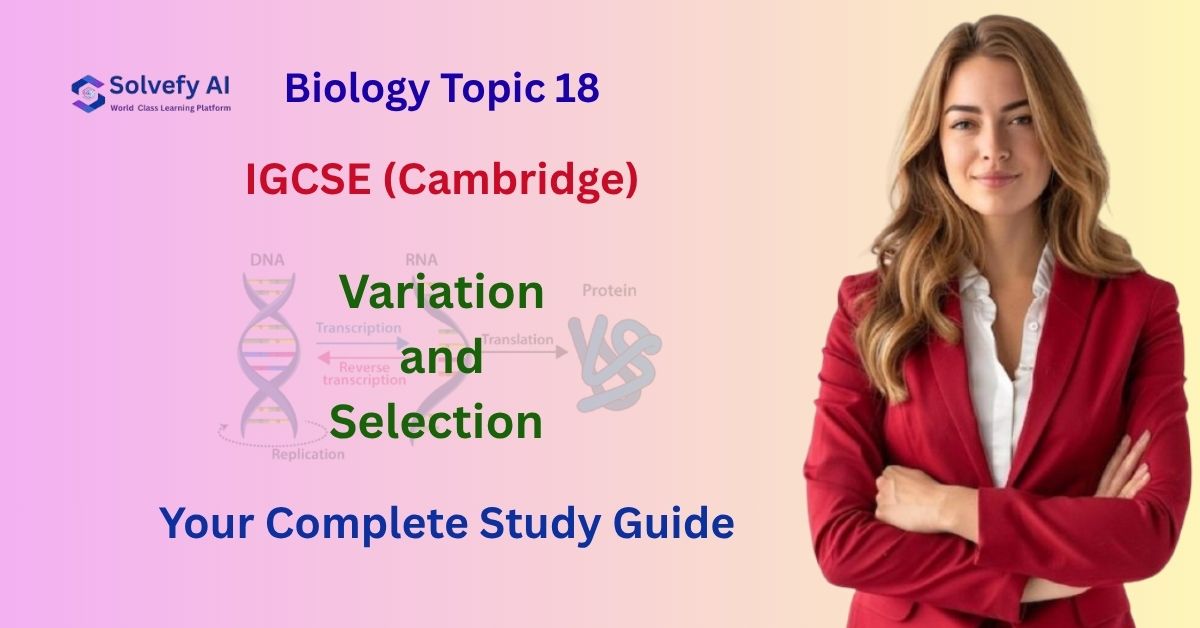
1 thought on “Variation and Selection | IGCSE Biology Topic 18 Complete Guide”